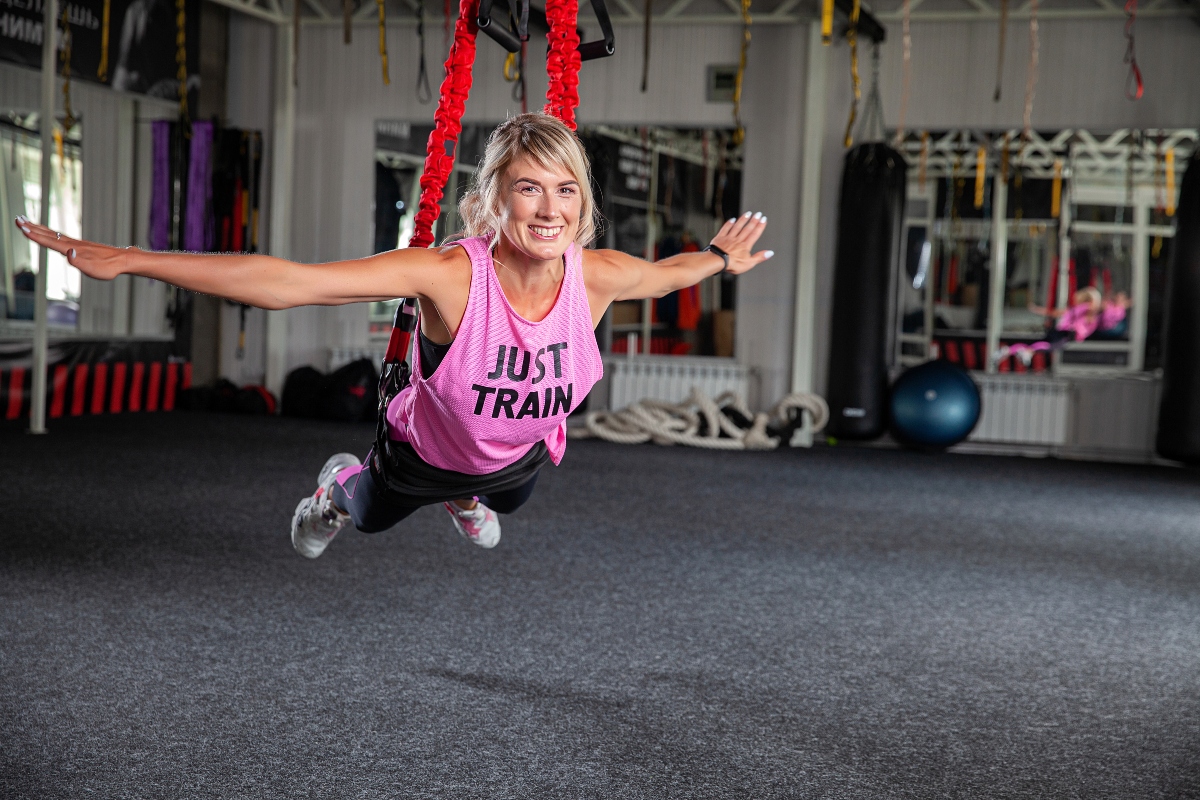Bungee fitness or aerial fitness with elastics is among the most innovative sports in the fitness world: it consists of suspended training with elastic cords that allows you to perform movements in suspension using elastic resistance.
An important clarification: no, it’s not bungee jumping. The only thing in common between the two activities is the elastic cord. Otherwise, you don’t jump from bridges or dizzying heights, but you work out in a gym or specially equipped space, always in safety.
Bungee gym is an energetic mix of suspended fitness, dance, and traditional training. It’s a complete activity that works the entire body: it’s a cardio workout that tones, improves coordination and posture, and helps burn a high number of calories.
Classes usually last between 45 and 60 minutes and are conducted in small groups using dedicated equipment.
It’s an activity suitable for beginners too, and its cost, which is quite affordable, varies depending on whether you take single lessons or buy packages.
What is Bungee Fitness?
Its origins can be traced to Thailand. In particular, a gym in Bangkok claims to have invented it. From there, the discipline spread and eventually reached America, where it gained further popularity.
According to other sources, Patty Cummings in Cape Coral, Florida, made a significant contribution to the discipline. Inspired by aerial arts and resistance training, she created a low-impact activity that combines fun, lightness, and well-being.
The user wears a harness (belt or “harness”) connected to one or more elastic cords. These cords are attached to the ceiling, beams, or metal structures capable of withstanding elastic tension.
The length, resistance, and tension of the elastic are adjusted in relation to the weight, height, and level of the user.
The system prevents the user from falling to the ground: you are “suspended” but not completely free as in bungee jumping. This allows you to perform dynamic movements in the air (jumps, bounces, twists), combined with more controlled exercises (like squats, lunges) using the push of the elastic itself.
The cord supports part of the body weight, allowing for wide movements, jumps, and acrobatics with reduced impact on the joints.
Bungee Fitness and TRX Training are two types of workouts that may seem similar for the use of “ropes”/harnesses but have different goals, methods, and sensations.
How a Bungee Fitness Class is Conducted
A bungee training class starts with a brief warm-up to familiarize with the harness and elastics, continues with the main exercises of jumping, running, and toning in suspension, and concludes with cool-down/stretching.
A standard class lasts from 45 to 60 minutes, although some gyms adopt shorter workouts (e.g., 30 minutes) to make the activity accessible to those with limited time.
Warm-up, Main Exercises, Cool-Down
The first 5-10 minutes are dedicated to warm-up: it starts with bodyweight movements to activate the muscles (dynamic walking, swings, joint mobility).
Then it moves on to the main exercises, which occupy the next 25-40 minutes. Here, dynamic sequences such as jumps, bounces, fast movements alternate with more controlled and loaded exercises: squats, lunges, push-ups, abdominal and core exercises, twists.
In more choreographed classes, dance moments and fluid transitions are also included.
Finally, the last 5-10 minutes are dedicated to cool-down and stretching. The intensity slows down, stretching exercises are performed for the engaged muscles, and breathing is restored with deep breathing and relaxation exercises.
Tips for Beginners
If you’re new to bungee fitness, we advise you to rely on an experienced instructor. They will surely have you start by modulating the elastic tension so that it’s light, to get familiar with the harness and movement.
Focus on breathing and core control, don’t force your body to perform complex movements from the first lessons: let your body adapt.
And on this note, listen to it: if you feel any discomfort or feel unstable, ask the instructor to lighten the elastic.
Last tip? Have fun.
Muscles Involved and Types of Exercises
Thanks to being practiced in suspension and its unstable nature, the core remains constantly active to maintain balance.
Moreover, depending on the exercises performed – jumps, squats and lunges – the legs (and thus the quadriceps, hamstrings, calves), glutes, and hip muscles are engaged.
As well as the upper body: when performing pushing, bending, pulling, or balancing movements, the shoulders, back muscles, chest, and arms are involved.
Finally, when performing rotations, twists, or aerial evolutions, the stabilizing muscles are also engaged.
Bungee Exercise
In bungee gym, you can perform various types of exercises, even combined, which allows the class to be more dynamic and fun.
Often, cardio phases – with fast movements and jumps – alternate with slower and more controlled phases to work on musculature and stability.
Among the most common exercises:
- Controlled jumps / bounces like jumping jacks. You jump and move up and down, changing rhythm.
- Suspended squats / lunges: from a suspended position, using elasticity to support the movement.
- Push-ups / presses: you can do push-ups or burpees mid-air using the support of the elastic.
- Dynamic abdominals: “crunch” exercises with elastic support, twists, and lateral movements.
- Core and balance: movements on one foot, twists, stabilization, even small lateral jumps.
In bungee dance and fly, you can also perform choreographic sequences, putting together a mix of movements, dance, and acrobatics, to the rhythm of music.
Evolutions and controlled flights, fluid transitions in space are also common.

Benefits of Bungee Fitness
There are several interesting benefits of bungee fitness.
They don’t just concern the physical aspect, but also the psychological one. In addition to promoting physical fitness, muscle tone, and weight loss, training with suspended elastics helps reduce stress and regain good mood, thanks to the fun that accompanies every movement.
Weight Loss
Being a dynamic and complete workout that works the whole body, and combines cardio, strength, and endurance with low impact on joints, it helps tone, burn calories and improve physical fitness.
The results, of course, also depend on consistency and diet, which should be healthy and balanced.
This form of suspended fitness and the elastic training it involves is a high-energy expenditure activity. Although estimates may vary, during an intense class you can burn between 700 and 1000 calories.
Its strength lies in the fact that the fun and motor variety it presupposes push the body to work even at a high pace, activating metabolism and promoting calorie consumption.
Cardiovascular Improvement
Since many sequences are performed continuously with variations in intensity (aerobic phase and elastic sprint), the heart is constantly challenged.
The cardiovascular system is stimulated in an alternating and progressive manner. This results in improved endurance, lung capacity, and heart rate.
Unlike many bodyweight workouts, using elastics allows you to modulate intensity and maintain a continuous flow without long pauses.
Fun and Stress Reduction
One of the most interesting aspects of bungee fitness is the playful element: feeling suspended, flying, performing evolutions, choreographies, changing direction, playing with gravity makes the workout much more engaging compared to traditional static exercises.
Certainly, the fun component increases motivation, consistency, and adherence to the activity. Moreover, it produces the release of endorphins that help reduce stress, anxiety, and mental tensions.
Who is it Suitable for?
Bungee fitness is suitable for anyone in reasonably good general health who wants to experiment with new forms of movement and is looking for an effective workout with minimal impact on bones and joints.
It’s ideal for:
- Those who want to change their workout and overcome the monotony of traditional fitness.
- Fitness, dance, or performing arts practitioners who want to integrate an aerial element.
- Those who want to try a stimulating and fun physical activity.
- Those who want to work on core, coordination, and balance.
- Those who want to train obtaining metabolic and cardiovascular benefits, but with less joint stress.
However, it’s not suitable for everyone: some physical conditions or pathologies may represent contraindications.
Those with serious back, disc, joint problems, or who have undergone major surgeries, should get the opinion of a doctor or physiotherapist before trying it.
In any case, relying on a certified instructor will ensure a workout suitable for your condition.
Generally, you don’t need to have much experience in aerial disciplines: many courses welcome beginners and dedicate part of the lesson to familiarizing with the equipment.
Where to Practice
Since a secure anchoring system is necessary, not all gyms are equipped to offer bungee gym among their courses.
It may therefore be necessary to turn to a center specialized in aerial disciplines or suspended fitness.
The advice is to do a web search.
For those wondering if it’s possible to practice bungee fitness at home, while it’s true that there are home gym models, it’s also true that they require a robust support structure, which is not always feasible within the home.
What You Need to Start
If you’re thinking of starting, you’ll need to get suitable clothing. But not necessarily specific. As you’ll see, the leggings you’ve used so far can also work.
Recommended Clothing
Among the clothing items you should use:
- A tight t-shirt or bodysuit and tight leggings, so they don’t interfere with the harness.
- If you want to avoid annoying friction with the latter, you can look for “cyclist” type pants reinforced in the crotch area.
- Sneakers with good grip.
Also, we advise you to avoid wearing jewelry, protruding accessories, or elements that could get caught in the elastics.
Equipment (if at Home)
If you’re considering practicing bungee fitness at home, to set up a home station you’ll first need enough free space to move in the air. And, subsequently:
- A sturdy structure, like a beam or a ceiling anchor point, capable of withstanding traction.
- Quality adjustable harnesses.
- Bungee elastics with variable resistances.
- Carabiners and secure connections.
If you don’t have adequate experience, we advise against improvising. It’s safer to start at an equipped gym.
Tips for Beginners
If you’re new to bungee fitness, we advise you to rely on an experienced instructor. They will surely have you start by modulating the elastic tension so that it’s light, to get familiar with the harness and movement.
Focus on breathing and core control, don’t force your body to perform complex movements from the first lessons: let your body adapt. And on this note, listen to it: if you feel any discomfort or feel unstable, ask the instructor to lighten the elastic.
Bungee Fitness near Me: where to Practice it?
You can practice bungee fitness at gyms specialized in aerial disciplines, in fitness studios that include this type of workout; in bungee dance fly centers or at facilities dedicated to bungee gym.
While in big cities like Rome, Milan, Turin, Naples you won’t have difficulty finding equipped gyms, in small towns the situation might be a bit more complicated: bungee fitness is still a relatively new discipline and not all sports facilities have the structures and trained staff to offer it safely. In this case, you might have to look for a center in nearby areas.
If you have the opportunity, you could start familiarizing yourself with suspended elastic training through trial lessons or introductory workshops organized as part of fitness festivals or local events.
Contraindications and Precautions
Although bungee fitness is generally safe for most people – it was actually born as a rehabilitation therapy – in some cases it might be better to avoid it.
It should be avoided by:
- Those with serious spinal problems.
- Untreated herniated discs, serious back conditions.
- Those with significant joint problems.
- Those who have undergone recent surgeries, particularly abdominal, spinal, or abdominal surgery.
- Pregnant women, as the harness at the abdominal level may be inadvisable.
- Those suffering from joint instability or serious medical conditions.
Safety and Certifications
Centers offering bungee fitness should rely on certified and properly trained instructors. To obtain a bungee fitness instructor certification, it’s currently necessary to complete a specific training course provided by recognized organizations.
In terms of safety, it’s important that the anchoring structures are tested and adequate for the load, and that the harness and elastic cords are regularly checked for any wear or damage.
Equally important, before a workout, is that the instructor adjusts the tension and length of the elastic cords, which, as you can easily deduce, cannot be the same for everyone.
FAQ (Frequently Asked Questions)
1- What is bungee fitness for?
It’s a fun and dynamic workout that helps improve strength, balance, coordination, and endurance. It’s ideal for burning calories, strengthening the core, and developing agility and body control.
2 – How much does bungee fitness cost?
The cost varies depending on the center and city: a single lesson costs on average between 15 and 25 euros, while monthly packages can range from 60 to 150 euros. In some gyms, you can take advantage of memberships.
3 – Does bungee fitness really help you lose weight?
It helps you lose weight if done consistently and with adequate intensity, provided it is combined with a balanced diet.
4 – Do you need experience to start bungee training?
No, you can take lessons designed for beginners, which include initial phases of getting familiar with the elastic and harness.
5 – Is bungee training suitable for those with joint problems?
It is generally less traumatic for the joints compared to other types of exercises, like jumping on the ground or running, thanks to the elastic support that cushions the impact. But in case of serious joint conditions, you should consult a doctor.
Conclusions
If you have a soft spot for innovative sports, bungee fitness might be for you: this elastic band workout combines the best of suspended fitness and cardio, stimulates all muscles, involves high calorie expenditure, improves the cardiovascular system, has less joint impact compared to many high-impact activities, and ensures fun and motivation.
If you want to try something new, working out while feeling light, bungee gym might be the answer.
Book a trial lesson and discover what it means to train suspended. Or, if you’ve already tried the bungee workout, share your experience in the comments.







